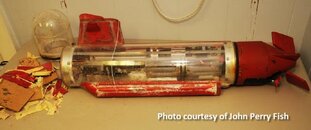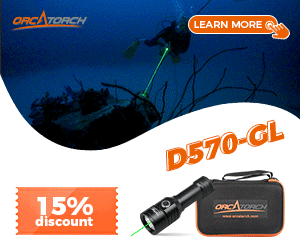munromh
Contributor
This definitely looks like a school project or enthusiasts project to me, see the picture I provided below.
New Bedford police trying to solve mystery of 4-foot-long underwater vehicle
NEW BEDFORD — It was not the typical piece of flotsam. Nestled among the driftwood, the seaweed and the bottles cast up on a local beach on Monday was a sleek red AUV, or autonomous underwater vehicle. The 4-foot long, battery-powered, torpedo-shaped device has a winged turret mounted on top for stability, a transparent midsection and sensors inside a strip on its underside.
There are still more questions than answers surrounding the discovery, which was made by the Port Security unit of the New Bedford police.
Where it came from, how long it had been in the water or what purpose it serves is unknown. The biggest question, that of ownership, remains a mystery, according to officer Chris Gomes who has been heading the search for its origins.
“It's definitely not military,” he said. “That was the first thing we checked.” Neither does it belong to UMass Dartmouth's School of Marine Science and Technology, the scientific institutions in Woods Hole or local defense contractors, he said.
Because the police want the rightful owner to claim it they are reluctant to release any more details about the find, including the exact location.
“It does have some serial numbers on it,” Gomes said. “But they are not anything that have an obvious meaning.”
Gomes said he has been in touch with an individual who builds AUVs, and if no-one comes forward in the near future, the AUV will be dismantled to determine what type of instrumentation it has.
Durval Tavares of Fall River knows a good deal about such things, having spent 19 years at the Naval Undersea Warfare Center laboratory in Newport before launching his own company, Aquabotix, to produce underwater devices for the commercial market.
Examining a photograph of the AUV, he immediately rejected the idea that it might be anything that was classified. “They wouldn't paint it red if it was secret,” he said. “I'd say this is a one of a kind.” The strip on the bottom likely contains a side scan sonar or a bottom profiler, he speculated.
AUV's are employed extensively for a variety of military, scientific and commercial purposes. Oil and gas companies use them to map the sea floor, scientists employ them to study the world's oceans and the military monitor harbors for intruders using AUV's which are sensitive enough to detect the presence of explosives in the hulls of passing ships.
“This one wouldn't go down very deep, judging by the midsection which seems to be some type of acrylic,” Tavares said. “It wouldn't withstand the pressure.” Noting that it did not appear to have many batteries, he said this AUV probably has a top speed of 2 knots and a battery life of three hours. “It's a small one,” he said.
Because of the possibility of loss, AUV's are routinely designed to have 2 percent flotation so that they return to the surface in the event of mishaps, such as flooding, he said. Most also have a ‘ping' so they can be located electronically.
“You can buy an AUV like this for about $50,000. But once you start adding sensors the price easily doubles or triples,” he said. “It's unlikely somebody threw this away. It probably belongs to some kind of school.”
Anyone with information or questions about the AUV can contact the New Bedford Port Security unit at (508) 989-2925
http://www.soundunderwatersurvey.com/Temp/CourtesyJohnPerryFish.jpg

New Bedford police trying to solve mystery of 4-foot-long underwater vehicle
NEW BEDFORD — It was not the typical piece of flotsam. Nestled among the driftwood, the seaweed and the bottles cast up on a local beach on Monday was a sleek red AUV, or autonomous underwater vehicle. The 4-foot long, battery-powered, torpedo-shaped device has a winged turret mounted on top for stability, a transparent midsection and sensors inside a strip on its underside.
There are still more questions than answers surrounding the discovery, which was made by the Port Security unit of the New Bedford police.
Where it came from, how long it had been in the water or what purpose it serves is unknown. The biggest question, that of ownership, remains a mystery, according to officer Chris Gomes who has been heading the search for its origins.
“It's definitely not military,” he said. “That was the first thing we checked.” Neither does it belong to UMass Dartmouth's School of Marine Science and Technology, the scientific institutions in Woods Hole or local defense contractors, he said.
Because the police want the rightful owner to claim it they are reluctant to release any more details about the find, including the exact location.
“It does have some serial numbers on it,” Gomes said. “But they are not anything that have an obvious meaning.”
Gomes said he has been in touch with an individual who builds AUVs, and if no-one comes forward in the near future, the AUV will be dismantled to determine what type of instrumentation it has.
Durval Tavares of Fall River knows a good deal about such things, having spent 19 years at the Naval Undersea Warfare Center laboratory in Newport before launching his own company, Aquabotix, to produce underwater devices for the commercial market.
Examining a photograph of the AUV, he immediately rejected the idea that it might be anything that was classified. “They wouldn't paint it red if it was secret,” he said. “I'd say this is a one of a kind.” The strip on the bottom likely contains a side scan sonar or a bottom profiler, he speculated.
AUV's are employed extensively for a variety of military, scientific and commercial purposes. Oil and gas companies use them to map the sea floor, scientists employ them to study the world's oceans and the military monitor harbors for intruders using AUV's which are sensitive enough to detect the presence of explosives in the hulls of passing ships.
“This one wouldn't go down very deep, judging by the midsection which seems to be some type of acrylic,” Tavares said. “It wouldn't withstand the pressure.” Noting that it did not appear to have many batteries, he said this AUV probably has a top speed of 2 knots and a battery life of three hours. “It's a small one,” he said.
Because of the possibility of loss, AUV's are routinely designed to have 2 percent flotation so that they return to the surface in the event of mishaps, such as flooding, he said. Most also have a ‘ping' so they can be located electronically.
“You can buy an AUV like this for about $50,000. But once you start adding sensors the price easily doubles or triples,” he said. “It's unlikely somebody threw this away. It probably belongs to some kind of school.”
Anyone with information or questions about the AUV can contact the New Bedford Port Security unit at (508) 989-2925
http://www.soundunderwatersurvey.com/Temp/CourtesyJohnPerryFish.jpg





